
Adolescence-Violence - waste of lives - Maria de Lourdes Trassi
Adolescence-Violence - waste of lives
Introduction
Adolescence is a time of great change and growth. It is a time when young people are exploring their independence and trying to find their place in the world. Unfortunately, it is also a time when many young people are at risk for violence.
Violence among adolescents is a serious problem that has far-reaching consequences. It can lead to physical and psychological injuries, as well as death. It can also damage relationships, disrupt schools, and create a sense of fear and insecurity in communities.
Causes of Adolescent Violence
There are many factors that can contribute to adolescent violence. Some of the most common include:
- Family problems: Young people who come from families where there is violence, abuse, or neglect are more likely to be violent themselves.
- Peer pressure: Young people who are surrounded by friends who are violent or who engage in risky behaviors are more likely to be violent themselves.
- Mental health problems: Young people who have mental health problems, such as depression or anxiety, are more likely to be violent.
- Substance abuse: Young people who use alcohol or drugs are more likely to be violent.
- Access to weapons: Young people who have easy access to weapons are more likely to use them in a violent way.
Consequences of Adolescent Violence
Adolescent violence can have a devastating impact on the lives of young people and their communities. Some of the consequences of adolescent violence include:
- Physical injuries: Adolescent violence can lead to serious physical injuries, including cuts, bruises, broken bones, and even death.
- Psychological injuries: Adolescent violence can also lead to psychological injuries, such as depression, anxiety, and post-traumatic stress disorder (PTSD).
- Relationship problems: Adolescent violence can damage relationships between young people and their parents, siblings, friends, and teachers.
- School disruption: Adolescent violence can disrupt schools, making it difficult for students to learn and teachers to teach.
- Community fear and insecurity: Adolescent violence can create a sense of fear and insecurity in communities, making it difficult for people to feel safe.
Preventing Adolescent Violence
There are many things that can be done to prevent adolescent violence. Some of the most effective strategies include:
- Strengthening families: Parents can help to prevent adolescent violence by providing a safe and supportive home environment, setting clear rules and expectations, and talking to their children about violence.
- Encouraging positive peer relationships: Parents and educators can help to encourage positive peer relationships by promoting social and emotional learning, teaching young people about the dangers of violence, and providing opportunities for young people to get involved in positive activities.
- Addressing mental health problems: Mental health professionals can help to identify and treat mental health problems that may contribute to adolescent violence.
- Reducing substance abuse: Parents, educators, and law enforcement can help to reduce substance abuse by talking to young people about the dangers of drugs and alcohol, and by making it difficult for young people to obtain these substances.
- Limiting access to weapons: Parents, educators, and law enforcement can help to limit access to weapons by keeping guns and other weapons locked up, and by teaching young people about the dangers of weapons.
Conclusion
Adolescent violence is a serious problem, but it is one that can be prevented. By working together, we can create safe and supportive communities where young people can thrive.
Call to Action
If you are concerned about adolescent violence, there are many things you can do to help. Here are a few ideas:
- Talk to your children about violence. Let them know that you are concerned about them and that you want them to be safe.
- Get involved in your child's school. Volunteer your time or join the PTA. This will help you to stay connected to your child's life and to the issues that they are facing.
- Support organizations that are working to prevent adolescent violence. There are many great organizations that are working to make our communities safer for young people. Donate your time or money to these organizations, or simply spread the word about their work.
Together, we can make a difference. Let's work together to prevent adolescent violence and create a brighter future for our young people.